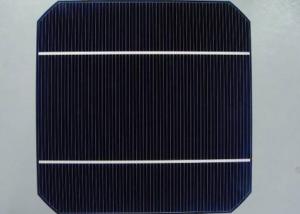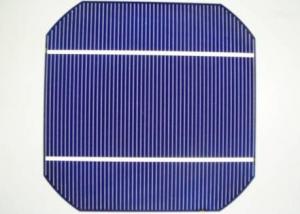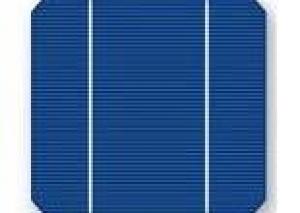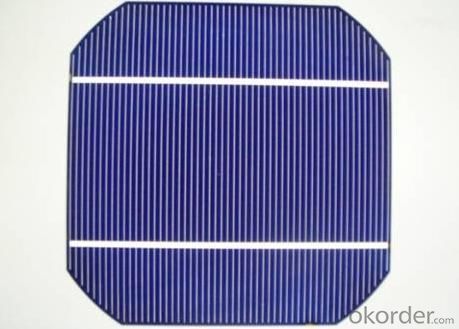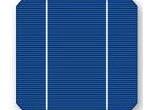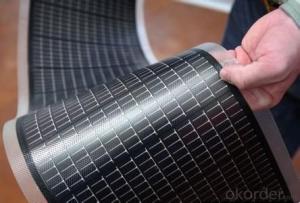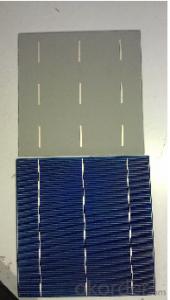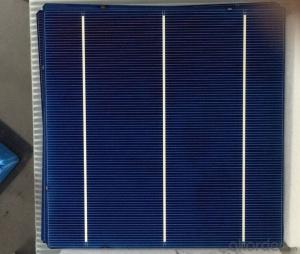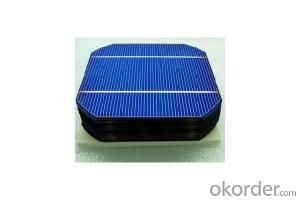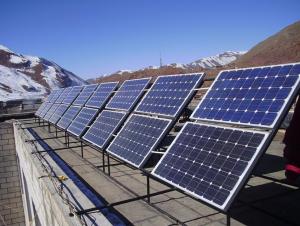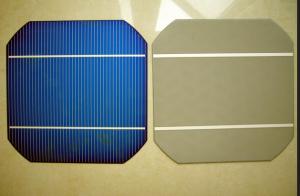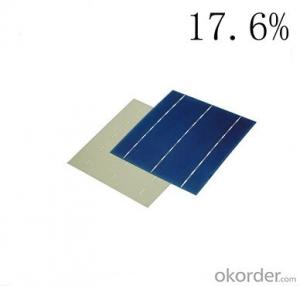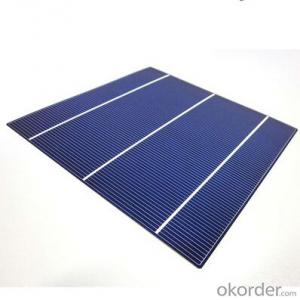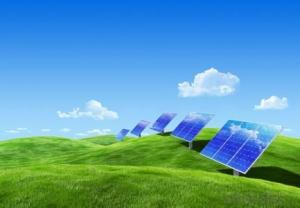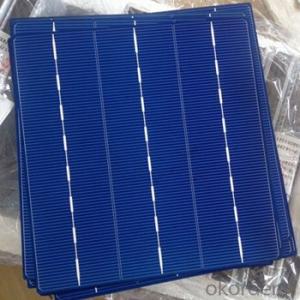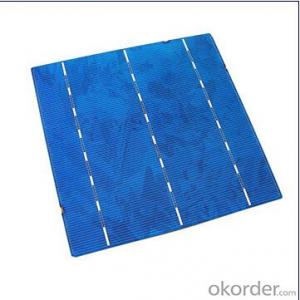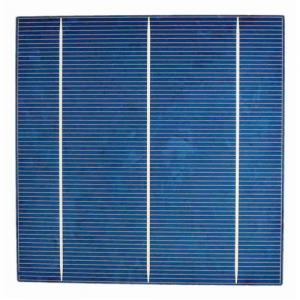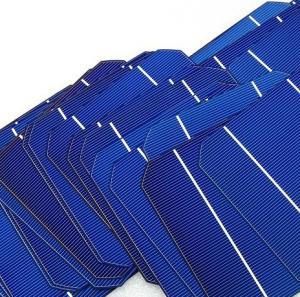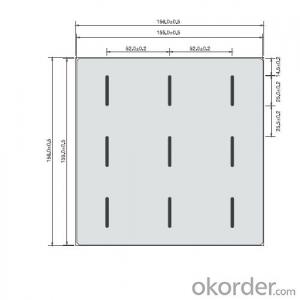Well Design High Efficiency Monocrystalline Silicon Solar Cells for Energy Transfer
- Loading Port:
- Tianjin
- Payment Terms:
- TT or LC
- Min Order Qty:
- 1200 watt
- Supply Capability:
- 700 watt/month
OKorder Service Pledge
OKorder Financial Service
You Might Also Like
Mechanical data and design of High Efficiency Monocrystalline Silicon Solar Cells
Format 125mm × 125mm ± 0.5 mm
Thickness- 210 μm ± 40 μm
Front (-) 1.6mm bus bars (silver),blue anti-reflection coating (silicon nitride)
Back (+) 2.5mm wide soldering pads (silver) back surface field (aluminium)
Temperature Coefficient of Cells
Voc. Temp .coef.%/K -0.35%/K
Isc . Temp .coef.%/K +0.024%/K
Pm. Temp. coef.%/K -0.47%/K
Electrical Characteristic
Efficiency (%) Pmpp (W) Umpp (V) Impp (A) Uoc (V) Isc (A) FF (%)
18.35 2.841 0.532 5.342 0.631 5.67 79.41%
18.2 2.817 0.53 5.319 0.631 5.64 79.16%
18.05 2.794 0.527 5.301 0.63 5.63 78.77%
17.9 2.771 0.527 5.259 0.629 5.62 78.39%
17.75 2.748 0.526 5.224 0.629 5.61 77.88%
17.6 2.725 0.524 5.201 0.629 5.59 77.50%
17.45 2.702 0.52 5.196 0.629 5.586 76.90%
17.3 2.678 0.516 5.183 0.626 5.577 76.71%
17.15 2.655 0.513 5.175 0.623 5.565 76.58%
17 2.632 0.51 5.161 0.622 5.559 76.12%
16.75 2.593 0.508 5.103 0.615 5.477 76.98%
16.5 2.555 0.506 5.047 0.608 5.396 77.88%
Brief introduction of Photovoltaic Cells Solar Panels
Photovoltaic Cells Solar Panels convert the solar radiation through the photoelectric effect or photochemical effect directly or indirectly into electrical energy by absorbing sunlight; the main material for most solar panels is silicon, but the production cost is so great that it cannot be a large number of widely and commonly used. Compared with ordinary batteries and rechargeable batteries, solar cells belong to more energy saving green products.
Advantages of Photovoltaic Cells Solar Panels
1) Solar energy resources are inexhaustible; solar energy shine on the planet currently consumes is 6,000 times larger than humanity to. Spread on Earth and the solar widespread, there are only local illumination can use solar photovoltaic panels, unrestricted area, elevation and other factors.
2), Solar energy resources are available everywhere, the nearest power supply. Without long-distance walks, preventing long-distance power transmission lines formed off the loss, but also has a throttling transmission costs. This is also the use of solar photovoltaic panels supplied premise transmission inconvenient western planning.
3), Energy conversion process of Photovoltaic Cells Solar Panels generating electricity is brief, which is a direct transition from photons to electrons. There is no central process (thermal energy into mechanical energy, mechanical energy is converted to electromagnetic energy, etc.) and mechanical activity, there is no mechanical wear. Based on thermodynamic analysis, Photovoltaic Cells Solar Panels generation with high theoretical efficiency, up to 80%, technology has great potential to develop.
4), Photovoltaic Cells Solar Panels do not use the fuel itself, does not emit any greenhouse gases and other substances, including gas, polluting air and noise, the impact will not suffer an energy crisis or the formation of the fuel market, is the real green environmental protection, new renewable energy sources.
5), Photovoltaic Cells Solar Panels generate electricity without cooling water process, the device may be in the desolate desert without water. PV can also be conveniently associated with the construction material, the composition of the construction of photovoltaic power generation system integration, covering not demand alone can choke precious resource site.
6), Photovoltaic Cells Solar Panels generate electricity without mechanical transmission components, operation, and maintenance simple, reliable operation of the same. A PV system only has a solar cell module can generate electricity, coupled with automatic control technology widely used; it can be done simply on unattended, low maintenance costs.
7), Photovoltaic Cells Solar Panels generate electricity tasking reliable, the service life (over 30 years). Crystalline silicon solar battery life is up to 20 to 35 years. In the photovoltaic power generation system, the only rational design, modeling appropriate battery life can last up to 10 to 15 years.
8), Photovoltaic Cells Solar Panels have simple structure, small size, light weight, easy to transport and installations. PV systems establish a short cycle, electricity load capacity vary, convenient and sensitive, easily combined expansion.
- Q: Can solar cells be used for military applications?
- Yes, solar cells can be used for military applications. They can provide a reliable and renewable source of power in remote and off-grid locations, reducing the dependency on fuel logistics. Solar cells can be used to power communication systems, surveillance equipment, and even provide energy for soldiers in the field. Additionally, solar-powered devices are silent, making them suitable for stealth operations.
- Q: How do solar cells convert sunlight into electricity?
- Solar cells convert sunlight into electricity through a process called the photovoltaic effect. The cells are made of semiconductor materials, usually silicon, that absorb photons from the sunlight. These absorbed photons excite the electrons in the material, allowing them to break free from their atomic bonds. The freed electrons then flow through the cell's material, creating an electric current. This current can be harnessed and used as electricity to power various devices and systems.
- Q: Is silicon-based solar cells and silicon-based thin-film solar cells the same?
- Silicon-based solar cells include silicon-based thin-film solar cells, including monocrystalline silicon solar cells and polycrystalline silicon solar cells. Silicon-based thin-film solar cells can only be in the form of thin-film silicon-based solar cells.
- Q: What is the cost of solar cells?
- The cost of solar cells varies depending on a variety of factors such as the type and size of the solar cell, installation costs, and government incentives. On average, the cost can range from $0.30 to $0.60 per watt for residential solar cells and can be higher for commercial or utility-scale installations. It's important to consider the long-term benefits and savings that solar cells provide, making them a cost-effective investment in renewable energy.
- Q: Can solar cells be used in telecommunications infrastructure?
- Yes, solar cells can be used in telecommunications infrastructure. They can provide a reliable and sustainable power source for various telecom equipment such as mobile phone towers, repeaters, and base stations. Solar cells are particularly suitable for remote or off-grid areas where access to conventional power sources is limited. Additionally, their installation can reduce operational costs and environmental impact, making them an increasingly popular choice in the telecommunications industry.
- Q: The working principle of solar cells includes the three processes
- The opposite of the electrical symbol of the photogenerated carriers in the solar cell pn junction built under the action of the electric field, the electron-hole pairs are separated, the electrons are concentrated on one side, the holes are concentrated on the other side, and the opposite sex charges are generated on both sides of the pn junction Of the accumulation, resulting in photogenerated electromotive force, that is, photovoltaic voltage.
- Q: Whether the solar cell is light can produce electricity
- A solar cell is a device that converts light energy directly into electrical energy by photoelectric effects or photochemical effects.
- Q: Can solar cells be used in remote communication systems?
- Yes, solar cells can be used in remote communication systems. Solar cells are capable of converting sunlight into electrical energy, which can be used to power various devices and systems, including communication systems. This is particularly advantageous in remote areas where access to traditional power sources may be limited or non-existent. Solar-powered communication systems have been successfully deployed in remote locations, providing reliable and sustainable connectivity.
- Q: How do solar cells impact energy poverty?
- Solar cells have the potential to significantly impact energy poverty by providing clean and sustainable electricity to communities that lack access to reliable energy sources. As solar cells generate electricity from sunlight, they offer an affordable and renewable solution for off-grid areas, reducing dependency on expensive and polluting fossil fuels. By enabling access to electricity, solar cells can improve education, healthcare, and economic opportunities, ultimately helping to alleviate energy poverty.
- Q: Are there any library or exhibition halls where I can show students at school how the solar cells works?
- I chose to go to the library with my students, where they can learn a lot from the books.
1. Manufacturer Overview
| Location | Zhejiang, China |
| Year Established | 2008 |
| Annual Output Value | Above US$ 320 Million |
| Main Markets | Australia; Asia; South East Asia; South America; North America; Europe; Africa |
| Company Certifications | ISO 9001:2008; CE; TUV; UL |
2. Manufacturer Certificates
| a) Certification Name | |
| Range | |
| Reference | |
| Validity Period |
3. Manufacturer Capability
| a) Trade Capacity | |
| Nearest Port | Ningbo, China |
| Export Percentage | 45% - 50% |
| No.of Employees in Trade Department | 200-300 People |
| Language Spoken: | English; Chinese |
| b) Factory Information | |
| Factory Size: | Above 10,000 Square meter |
| No. of Production Lines | 8 |
| Contract Manufacturing | OEM Service Offered; Design Service Offered |
| Product Price Range | Average |
Send your message to us
Well Design High Efficiency Monocrystalline Silicon Solar Cells for Energy Transfer
- Loading Port:
- Tianjin
- Payment Terms:
- TT or LC
- Min Order Qty:
- 1200 watt
- Supply Capability:
- 700 watt/month
OKorder Service Pledge
OKorder Financial Service
Similar products
Hot products
Hot Searches
Related keywords
